of Lena and Baikal mountains - finally here!  The station building from Ust-Kut, which carries the station name Lena
The station building from Ust-Kut, which carries the station name Lena
 Soon we will cross the Lena - Oliver photographed constantly.
Soon we will cross the Lena - Oliver photographed constantly.
 We wind up in the Baikal Mountains, surrounded by two of thousands of peaks.
We wind up in the Baikal Mountains, surrounded by two of thousands of peaks.
04:07:06: Oliver had decided to get up early that day. He wanted to enjoy this last day of travel the varied landscape, which would result from Ust-Kut past us. Even before the arrival in get up Ust-Kut , had to get up early - very early, compared to recent days. Of course, also increases the excitement, if such a long car ride coming to an end.
Thus, we are on our arrival at the station Lena - this is the station of Ust-Kut - alert and ready for the first exit of the day. This time there are also some photos from the station. The sun is just rising and casts a long shadow. After the train is moving again, we roll through industrial wasteland. We see a building fire, but which is deleted by some fire departments and almost smoldering plumes of smoke rising from the charred building can be. Then the train clings ever closer to the west bank of the Lena and reveals a view of the river across to the wooded slopes of the eastern side.
Oliver is already armed with a camera to document the trip on the Lena photographs. Finally, we cross it, the Lena, which flows freely from dams to the Arctic Ocean and from Ust-Kut is navigable downstream - but only at the ice-free season from June to October.
After we passed the railway bridge, curve the tracks again to the mountain slope and slowly gain altitude. After we have already climbed to an impressive height of the Lena, the BAM adopted by the Lena, with a last breathtaking views of the majestic valley and swings in a side valley, which belongs to the foothills of the Baikal Mountains.
 entrance to the tunnel before Severobaikalsk BAM - for a railfan Oliver oligatorisches photo.
entrance to the tunnel before Severobaikalsk BAM - for a railfan Oliver oligatorisches photo.
 The first day in Severobaikalsk - a fast-food meal under the umbrella on the central square.
The first day in Severobaikalsk - a fast-food meal under the umbrella on the central square.
 view from the central square towards the hinterland.
view from the central square towards the hinterland.
begins for us one of the best BAM-sections. Although there are still many hours to Severobaikalsk, one finds little time to eat or pack up the items for the upcoming arrival. The changing pristine mountain landscapes attract constant views.
is some point where it and we pull a big loop around Strelka, before entering the first big BAM tunnel. Oliver also busily photographed. The conductor asked us to close in the tunnel window. He told us we would whisper of any radiation in the tunnel. Even if I do not believe the law, may we close the windows so that simply no musty tunnel air penetrates into the car. On the other side of the tunnel we are almost there. By Davan we drive along the valley of the river Goudshekit and after its confluence with the Tyja Tyja along the valley up to Lake Baikal, where the train station at Severobaikalsk holds.
Now we are here - finally! After disembarking, we can discover no "welcoming committee". A little later appears Ljuba and welcomed us warmly. When she learns that Matt has not come along, she is disappointed visible, but only for a short time. Together, we drive to the SchTEO - the School of Tourism and Environmental Education ", which Staff of the same GBT and hostel is.
In SchTEO (Russian ШТЭО), we make further acquaintance. All are busy to pack tools and supplies. We decide to stay in SchtEO and bring our bags in the room. After welcoming all friend, I am going with Aliona in a shed where there is the steel cable. There are two down in rings of rope with a diameter of 11 mm and a very strong individual wires. It is therefore very stiff and brought my cable clamps really too thick, because I had that selected for a 10-mm rope. Then I checked with Aliona the tools. We found that we needed some special things, such as a hacksaw. Aliona summarily decided that I should go with Yegor in a hardware store and get the missing items. Yegor chauffeured his father the car there and we bought everything we needed.
Back in SchTEO all other preparations were already made and we said goodbye for the rest of the day from our Russian friends. Then we went into town for dining and entertainment. Back in SchTEO finally found a night's rest at one of the local dormitory rooms.
The distance Yenisei and other highlights 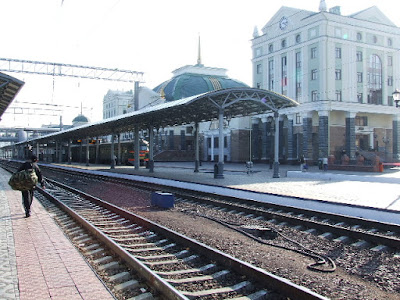 The new station building Krasnoyarsk was completed in 2006
The new station building Krasnoyarsk was completed in 2006
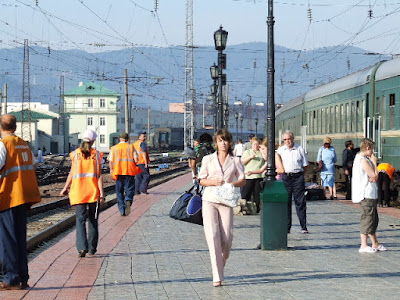 This time is paved and the new platform, not a mist over the mountains to the east front of the Yenisei.
This time is paved and the new platform, not a mist over the mountains to the east front of the Yenisei.
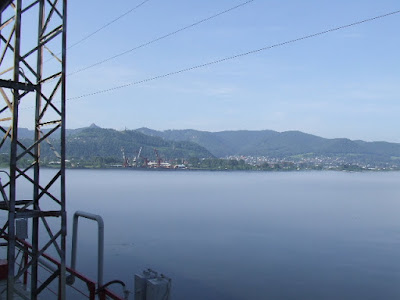 The distance Yenisei - the most water Siberian current.
The distance Yenisei - the most water Siberian current.
03:07:06: The early morning greets us in Krasnoyarsk. We take a morning walk along the platform, which we encounter bustling with activity in the morning sun. We note that the new station building is now completed and the platform is now paved, which last year was still under construction. Only a few remaining work of construction workers performed. The view east is impressive as last year. The mountain range forms a barrier across the Yenisei in the haze. Only the fog over the river this time are not there. Viewed from here, you can hardly believe that even before the mountains flows a mile-wide river.
After a few obligatory purchases and photos on the platform it is again: All aboard! Then we continue and we roll out of the station, first over to the new buildings of Krasnoyarsk, and then the railway bridge.
Christian makes us to a work site near the river closely. On a large area are agricultural machinery, especially combines. This work was one the largest in the former Soviet Union and built to combine the VEB to progress under license.
Then we roll over the bridge and marvel at the mighty Yenisey stretching, which is considered the most water Siberian current. Finally, we dive into the western foothills of the Sayan Mountains.
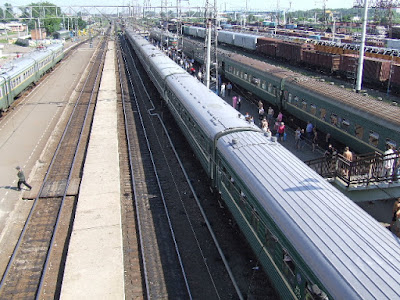 Taishet - View from the pedestrian bridge to the east, where they are separated by the Trans Siberian BAM.
Taishet - View from the pedestrian bridge to the east, where they are separated by the Trans Siberian BAM.
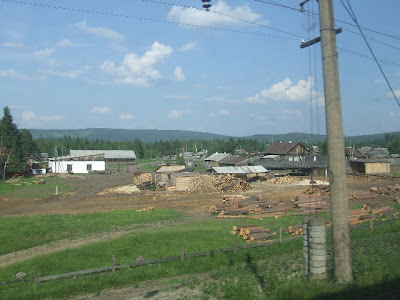 At BAM, the picture changes: forests, little agriculture, but forestry.
At BAM, the picture changes: forests, little agriculture, but forestry.
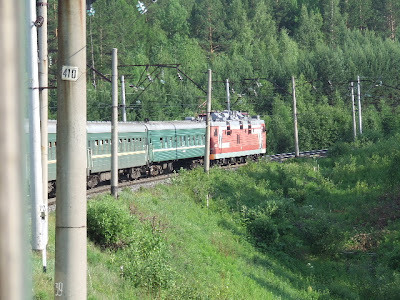 moves slowly relative to BAM its curves through the taiga.
moves slowly relative to BAM its curves through the taiga.
Now the landscape is varied and draws me back like last year in his car. It is this alternation of taiga and steppe landscape, which fascinates me.
About seven hours we drive so - with a longer stop in Iljanskaja - to Taishet. Railway experts know: This is where the chaff from the wheat. The wimps go south to the Trans-Siberian Railway to Irkutsk, the tough guys but go north with the BAM. Well jokes aside, here in Taishet is the last station of common age-Trans-Siberian and BAM, the Baikal-Amur Mainline. After the train has left Taishet, one can very well see how the two rail lines to dig up, the Trans-Siberian Liene pans with multi-track pomp to the southeast, and the BAM-line modestly less traveled, and later single-track line edges away in the northeast.
BAM is different from the ancient Trans-Siberian Railway. One sees fewer places, little more agriculture, but a lot of taiga. The few places through which we roll, are usually only Holzverladestationen the forestry along the railway line.
This landscape will change to Bratsk little more and that will be around midnight. The giant dam of the Bratsk Hydropower Plant, we will then admire more in the dark can only see the lights of Bratsk will be reflected in the huge water reservoir.
West Siberian Plain 
new buildings on the outskirts of Novosibirsk.

cargo ships on the Ob, the second giant Siberian river, we pass to the Irtysh.
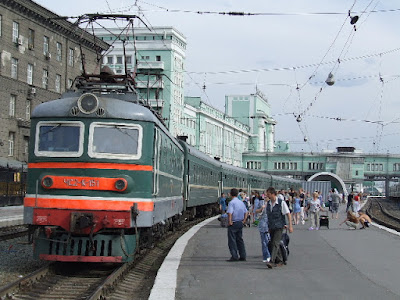
At the station of Novosibirsk - our train was standing on the platform there and hustle and bustle.
02:07:06: This day is dedicated to the monotonous West Siberian Plain. Endlessly she is gone and drag bring us a day of leaden monotony, broken by many stops, and only two major cities loosened, which we will cross each one of the Siberian rivers - and then only Omsk Novosibirsk.
In Omsk I'm too lazy to develop any such activities. Therefore, unfortunately, no pictures of the city or the river caused Irtysh. The Irtysh is the first west of the Siberian giant streams that flow into the Arctic Ocean. It joins the lower reaches of the Ob and forms with him a giant estuary.
Omsk Behind the endless plain begins in earnest. There are no closed forest cover more. Endless meadows, often wet meadows dotted with vegetation bins of individual birch trees pass by. We use the time to get to know us better. Above all, we learn about Christian. Above all, his professional experience from the East German agricultural machinery produce some interesting history. In the afternoon we reach
Novosibirsk. The city is relatively young and was only at the beginning of the 20th Century, the town charter. In contrast to Omsk and Irkutsk, the city that rose until the construction of the Trans-Siberian as a settlement, virtually no historic buildings. Nevertheless, it is now considered the capital of Siberia, although officially it is not the title. But it is home to several Consulates, including the German agency for the entire region, Siberia.
Already on the west bank of the Ob can be seen extensive building activities. The city seems to boom. Then we cross the Ob, within which there is lively freight shipping. Finally, we are rolling in the Novosibirsk central station.
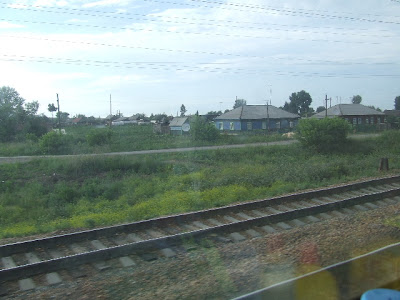
endless flat desert of western Siberia.
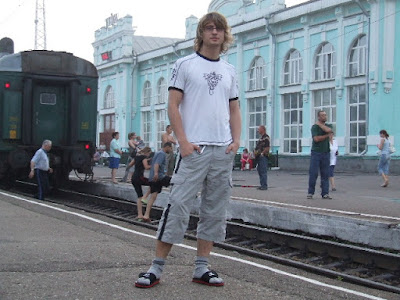
Taiga Station - evening stop: There are actually more forest again seen along the route.
Here again there is a long stop. Since it is a must, to stretch your legs and into the colorful travel to the station.
For Oliver, of course, is the company's train "Sibiryak" a photo event. We wander around a bit on our side on the platform, pedestrian bridge and the station building until the wagon companion reflect the signal for boarding.
And then we roll to the east. Moscow time, and thus according to the Russian railway clock time is 15:08, but after time it is 18:08 clock - it's already on the evening. During our last big stop on today's date "Taiga" there are already four-hour time difference between Moscow and we are. Until then, there are still about three hours.
In the vicinity of the station Taiga Landscape the name again just stronger. Rather than have the expansive meadows with individual birch trees it again more closed forest with mainly coniferous trees. Here we complete a final walk on the platform. Aside from the passengers of our train has left the station of Taiga but pretty. Then we continue and we roll into the night.
Kama - Ural - Asia 
As in the previous year, I was amazed at the width of the Kama, which is only a tributary of the Volga.
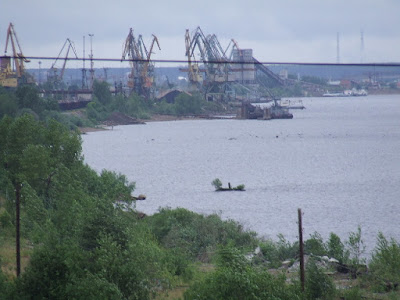
located on the Kama Perm, an industrial city and inland port west of the Urals.
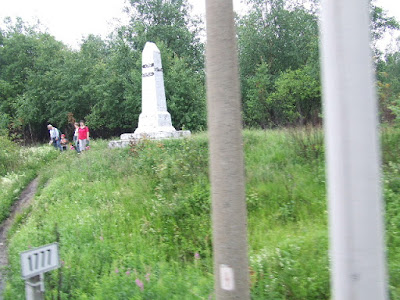
At km in 1777, an obelisk marks the border between the continents of Europe and Asia.
01:07:06: passed in the night we Kirov and in the morning we had a Lokwechselhalt in Balesino. By late morning, we finally crossed the Kama and thus reached Perm. Again I was amazed at how in 2005, but for what the Kama is a huge river. Although it is only a tributary of the Volga, it can easily compete with the lower reaches of the Danube. This time I also managed a few photos. Finally
we held in Perm . The city is the train is not overly welcoming. Also on the banks of the Kama it is more influenced by huge inland port facilities as a skyline of the water - at least what one can see from the train like that. The city is in fact primarily an industrial city. The oil company Lukoil is headquartered here.
Perm is on the route, the last major city west of the Urals, and thus also in Europe. We roll on and there it gradually becomes more hilly. These are the first foothills of the Ural what we have achieved. Much more mountainous it is along this route can not be.
Olga seems at odds with the technology to stand. First they had a problem with their Clock - Watch With a newly acquired fitness functions. She had no instructions with it, but wanted time to the new time zone switch. Here I was with a little patience and Probiererei finally getting the hang of it and help her. With her phone it was not me. It was also new. Olga said there would be no provider lock and could be used with any Sim card. Therefore, they had bought in Moscow a cheap Russian prepaid card and then inserted into the phone. But obviously it was a lock, probably set a provider lock in mobile phone firmware and it did not work with this Russian map. Worse was that then the phone was completely blocked and no longer accept the old card. There was then, despite some Probiererei to do anything.
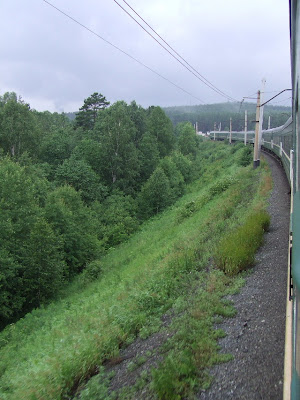
through the rolling hills of the southern Urals, the tracks wind up Yekaterinburg.
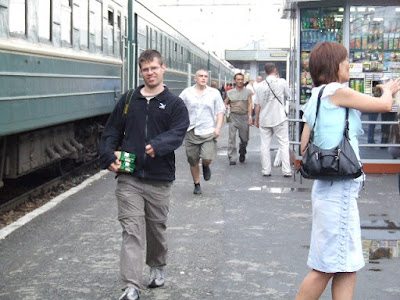
purchase food on the platform in Ekaterinburg - Oliver with food in her arms.
Ekaterinburg Shortly before the 1777 km we reach the border between Europe and Asia. This time I was also a snapshot of inconspicuous on the edge of the rails stationary white obelisk that marks the border. Soon after we reach Jekaterienburg .
In Jekaterienburg is the last chance for today to buy food and something to stroll on the platform. The city is historically significant, not least because of the 1918 murder of the Tsar's family. She competes in the ranking of the largest Russian cities with Nizhny Novgorod to place 3 Sorry, we can see from the train not too far from the splendor of this city, but a little walk on the platform, at least in it. should
a stop there today, but it will already be in the dead of night. And although in Tyumen and this time we will again (as in 2005), only the nightly light show to get this city presents. The rich Petroleum and natural gas city shows its rise during the night and its neon signs and lavishly illuminated magnificent buildings, shopping malls and high streets. As the symbol of the West Siberian oil production is a brightly lit oversized oil rig in sight of the railway line - designed as a kind of Eiffel tower derrick - where we roll over after we leave the station from Tyumen. But then final night's rest the day.
train No. 92IJ - Wagon Lux 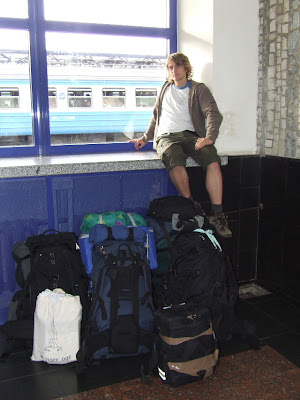
While Regina, Christian and Oliver still fast food procured, I waited with John and the luggage in the station hall.
06/30/2006: Our position on the platform was well chosen. The car of the first class - Wagon Lux - holds close to us. The door opens and a Provodnik, a male guard gets out.
We present our Bilet him. Although there are tickets in question was purchased in Moscow (from Oliver's Railway Employees acquaintances), they confuse our Provodnik first. The space reservations are already from Moscow (Kazansky Railway Station), the tickets are issued as such from Gorky. Oliver also wants to see the same clarified that he has booked an entire compartment to itself as "Single", which brings the train crew completely confused. He flips around two minutes in the ticket (each of which consists of several sheets) and waves will eventually: "Get in," he says to us, "That I watch later at your leisure. And now we drag our bags in single file down the hall and demonstrate our compartments.
Even as we look around us in the hallway, we spoke to a woman. "You are the other volunteers, I accept your T-shirts." So this is Olga, our still missing German participant. Later we learn it at the evening get-together to know more detail.
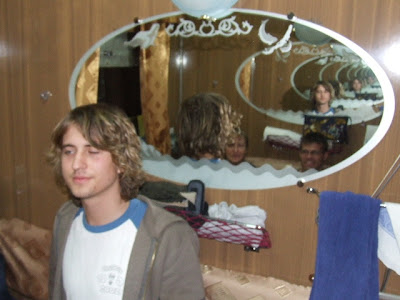
Instead of the upper bunk hang Lux-length mirrors in the car with stylized Baikal motif on the walls - a hallmark of the 92-ger train.

is otherwise a lux car identical to the Kupejny sleeping car, ...

... only plush and even for only 2 people are relatively more space.
Our cabins are really no different than the usual "Kupejnye" compartments. It lacks the upper bunk. Therefore, one has to second-and correspondingly more space than four people and it is on the bunks, which indeed are also benches, sufficient headroom. The compartments also plush equipped. Instead of the upper bunks adorn large, oval, almost Victorian-looking mirror the walls. They are decorated with stylized motifs Baikal. This and some other feature of this campaign, such as curtains or the board range of mineral make clear that we take the train "Moscow-Severobaikalsk Severobaikalsk. It is used in Severobaikalsk and operated under the responsibility of the local railway department. Later we sit
together and share our resources. Unfortunately, our urgent shopping trip was on the station square of Nizhny Novgorod, not very productive. But Olga drags a huge bag of only about food. She had a stopover in Moscow on their Relationship is inserted. There was her brother, apparently a new rich Moscow, given her a huge supply of food, which they had extra to buy a new bag. Even Italian ham was there.
Olga is German-Russian descent and lives in Heidelberg, where she is researching a scientific foundation of topics in genetics. She has a doctorate in biology. It proved to be very communicative - others would call it talkative and dominates with its somewhat self-centered nature often the conversations in the group. Oliver will tell me later, questions whether I is not even on my nerves. Well - everyone has their own characteristics. We will judge us as a group how well we are clear with each other to come. I made up my mind, I do not make a decision too quickly.
Our Provodniks, a couple whose male part, we had already seen, we concluded soon friendship - especially Olga, who developed a relationship with Tanya, the Provodnitza, there was a well Volga-German descent and quick with her a heart and a soul was.
An afternoon in Nizhny Novgorod 06/30/2006: 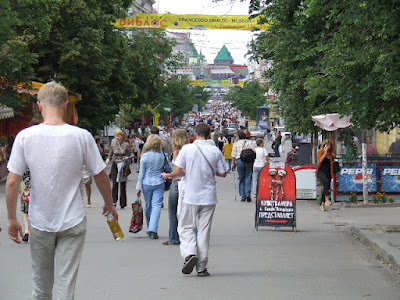
The Bolshaya Pokrovskaya is the celebrity Nier road from Nizhny Novgorod. It runs from Gorky Square to the defiant Kremlin.
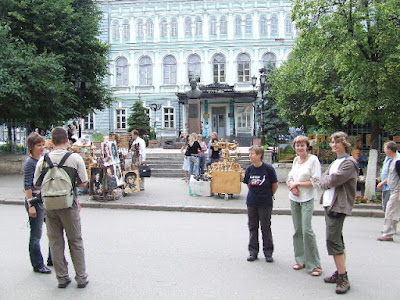
Historic buildings line the avenue and Marina and Sweta us to know about it.
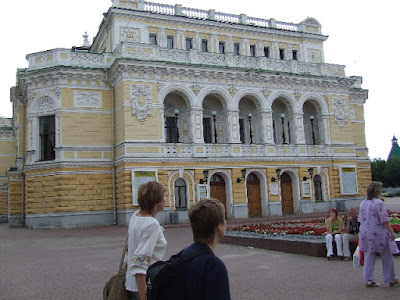
Theatre in Ekaterine classicism - this cake style is still used in Russian architecture, inspired by love.
Thus began our stroll around town - so to speak, officially - at the Maxim Gorky monument. Of course they are proud of this famous son of the city, whose name she bore Soviet times. Finally, his literary works, even if he manipulated by the Soviet cultural policy as a proletarian poet, without controversy.
We stroll along the Gorky Square and enter the Bolshaya Pokrovskaya - a central Promeniermeile the city. This boulevard is a pedestrian area of superlatives. With 1.4 kilometers long, it is probably the longest pedestrian street in Russia. Who here expected massive Stalinist buildings will be pleasantly surprised. It dominates Ekaterine classicism. The road is quite comparable with the Moscow Arbat. But somehow she is likeable to me than the Arbat, which is perhaps the light summertime atmosphere, or only on the non-existent crowds of Nepphändlern - it just seems comfortable, in spite of the masses who are here on the road.
We walk along this road. From time to time, we remain a family portrait session, are and Sweta or Marina tells us about one or the other architectural highlights, or just interesting things about the city.
Nizhny Novgorod is a city of millions. Only Moscow, St. Petersburg and Novosibirsk are surely greater. Otherwise, Nizhny Novgorod, Ekaterinburg competes with for fourth place on the list of the largest cities in Russia . Sweta is sure: our city is the fourth largest in Russia. According to Wikipedia, but has already Ekaterinburg Nizhny Novgorod by 2006 advanced to fourth place, albeit with a few thousand inhabitants more.
The street is lined with trees or alternately of renovated old building facades. Countless shops, kiosks and cafes offering their services. In front of a historic building of the University of paintings are offered for sale.

Then and now: Inside the Kremlin are churches and prestigious office buildings. To our right (not pictured) is on the eternal flame, is behind the Kremlin wall, a majestic balcony overlooking the Volga.

The Kremlin was once built on a hill below the Okamündung. Here you can look up and see Volga left behind the Kremlin Oka lead.
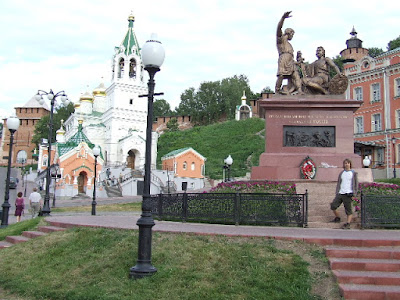
The Minin and Pozharsky monument in the old city beneath the Kremlin.
In the distance, at the end of the Boulevard, is one of the Kremlin towers visual completion. Comfortable step, we approach him. Past a historic building of the Russian bank and the theater in the classical style.
Finally, we are faced with the Kremlin. This was once the fortified city limits. The fortified walls to fend off the attacks of the Tatars and Mongols, and this they did with success. This dramatic of all the Kremlin in the Russian Grand Duchy was the attacks of the Tatars in 1520 and 1536 stand.
Now is the gate open to visitors and we enter the interior of the Kremlin. Right hand is directly behind the Kremlin wall is a gallery of historical military equipment: tanks, howitzers and the like. It will probably symbolize the military machine of the city.
We walk through the Kremlin to the upper limit in the direction of the river bank, past representative office buildings and religious buildings. This is also the eternal flame. Behind it opened a breathtaking view over the Volga River and the mouth of the Oka to the left.
We leave the Kremlin by one of the landward gates and walk outside the Kremlin wall along the eastern. Here's a fairly new, gorgeous Free staircase was built, over which one can go down the Volga. Also here to stay and we enjoy the view. Then we get down to the old town on the river bank.
Here we are surrounded by historical buildings. About fortified tower on the walls of the Kremlin. We come to a monument that strikes me as strangely familiar. It is the monument to Minin and Pozharsky , which is just as well as in Moscow's Red Square. Sweta says this: Of course, the original monument in Moscow, because the heroes Minin and Pozharsky the liberation of Moscow from the Polish-Lithuanian occupation in 1612 are. But Minin and Pozharsky Nizhny Novgorod are sons and advanced with a volunteer army from our city to Moscow. Therefore, they are also heroes of this city. For this reason, we have built here a faithful replica of the Moscow Minin and Pozharsky monument.
After this digression, it is already time to go back to the station. By Sweta we leave here, Marina accompanied us to the train. With a local bus proppevollen again we return to the station where we purchase food in a hurry and get the backpacks from the luggage storage. We enter the platform as our train coming from Moscow, already rolling up.
From the Golden Ring to the Volga 06/30/2006: This is the third day of travel. In the early morning hours, we have passed the Moscow region and roll now by Golden Ring , a belt of historic towns, often marked by golden church domes and fortifications - the so-called Kremlin - should that protect once the outer limit of the " Moscow Rus .

The Golden Ring - a belt of ancient cities around Moscow - characterized by old wooden houses on the one hand ...

... and churches covered in gold and other Kremlin, which once secured the border of the "Moscow Rus".

Vladimir, Suzdal find the best-known city of the Golden Ring.
Vladimir is probably next Suzdal and Sergiev Posad (former Zagorsk) the most famous city of the Golden Ring . The Russian Railways Vladimir devotes a change of locomotive and thus holds long enough for it to at least be able to stroll around a few minutes on the platform. The Golden Ring effect on me, as if time stood still. From Moscow's boom or a boom, such as in Tyumen by the crude oil here is nothing to feel or see. But I am convinced that this will also come here. The Golden Ring has both tourist potential, but also - by its proximity to Moscow - an advantage for the economy.
But now is our support has come to an end and we continue to roll, past ramshackle old wooden houses in the direction of Nizhny Novgorod on the Volga.
Here it should according to Oliver's planning to go as follows: In Nizhny Novgorod (formerly Gorky) we get out. Our connecting train goes as planned until the evening, so we'll have time for sightseeing. Here again, Oliver has been planned and we are in the Marina, a friend of Oliver awaits at the station.
Marina speaks good German. They welcomed us warmly and invites us on a guided tour. First we get our big backpacks luggage and then we enter the station forecourt. This is where they are as Nizhny Novgorod booming city. Life swirling heavy traffic, colorful kiosks, new bank buildings and signs all around shape the first impression. We are struggling in the wake of Marina by a bus stop. Soon we ride in a proppevollen local bus to the city center.

The platform in Vladimir - it seems the whole train is of the legs.
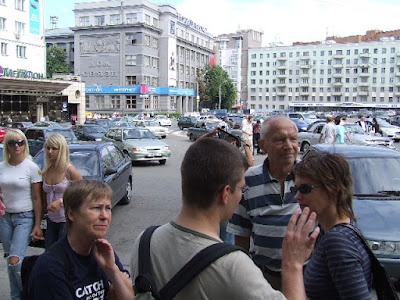
After a bus ride from Station in the city, we start our city tour on Gorky Square.

Christian and Marina on Gorky Square - this is still Sweta join us.
Nizhny Novgorod is located on the site where the Oka flows into the Volga, one can say at the mouth of a mighty river into an even more powerful.
Nizhny Novgorod, known as the birthplace of Russian / Soviet proletarian writer Maxim Gorky , after the city was named in Soviet times, but also as the armorers of the Soviet Union, the center of heavy engineering and exile of dissidents Andrei Sakharov . The city was until recently closed to foreigners. Very exciting but the history of Nizhny Novgorod and the traces on which we can convert the next few hours is.
We emerge from the bus near the Gorky Square. The day is sunny and hot. The smells of summer are intense city. Near the telephone exchange is a classic mobile Kwasfass . I have not seen for a long time! exchange in a bank on the corner of our money. Then we stroll among flower beds on Gorky square up to the Maxim-Gorki-Memorial, where we have arranged to meet with Sweta.
A woman approached our group is welcomed warmly by Oliver. It is Sweta. Also, she speaks very good German. Finally, also a German teacher. Together, we will start our city tour in which we Marina and Sweta alternate talk about important things about the city.
Belarus - Transit 06/29/2006: reached in the early hours of the morning we cross the border. The train is a long time in Poland. This rise to the Belarusian border guards. The car attendants and passengers wake us soon come the controls - the first Polish then the White Russian.

A stop in Belarus - unfortunately I had failed in Brest, to To photograph there, although we had a long stop.

Minsk - the capital of Belarus. A view from the train station.
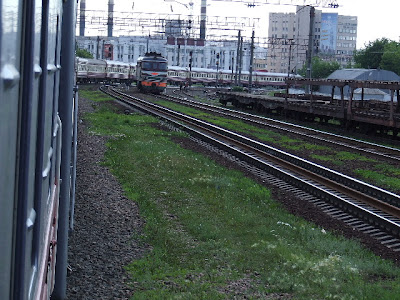
We leave Minsk. In this curve the length of our train is clear.
The Belarusian control is carried out on behalf of the Russian Federation. On the border between Belarus and Russia, it will never be any more checks. Although we therefore first in the transit country Belarus are, so to speak, we have also passes the outer border of Russia.
The checks have not really awake can be, so we continue to dawn as the train is uncoupled for gauging the wider Russian gauge in sections and the Umspurhallen is rolled. Here I observe - lying face down on my bed - the bustle of the railway workers, while we float with the lifts in the air. And I always nod again. Half asleep, I experienced the gauging procedure and rolling into the station of Brest. Our car was there been separated from the rest of the train that would go directly to Moscow and yes we were on a siding at the east end of the station "parked". The train to Kazan was only hours later deployed and coupled our car there be.
Inwischen were all awake and had her morning toilet and breakfast behind - time for a walk. The Provodniza us asked us not too far away from the wagon - he could also be out ranked somewhere in between. Probably she was more afraid we would forget the time or get lost. Ultimately, we respected their request and strolled back only to the station and, while Oliver was a lot of photos. I had (unfortunately) waived to bring my camera.
Somewhere there was a shunting locomotive moved into our siding and our car was coupled to the train to Kazan and subsequently provided before the Brest railway station. Our stop in Brest thus lasted about 8 hours from 3:05 bis 11:13 clock time clock Eastern European (of which we were sleeping or dozing but the first few hours).
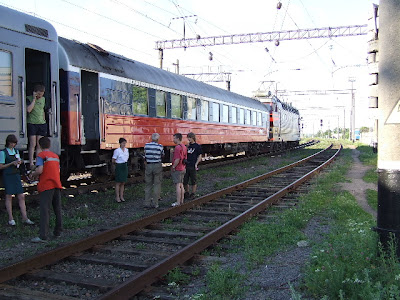
Not every station has ready platforms that are long enough for our train. Thus, the head of the train is already outside the station.

John has cared for the first time in Russia: The ice for now, the beer for after.

Last stop in daylight in Smolensk.
But then we rolled through Belarus - now on a broad Russian track and having weighed the calming and rhythmic banging the bogies.
This day between two nights in a "small" umspurfähigen standard gauge wagon , which is exceptional in addition to the broad gauge wagons a little thin (see photo on the left or see here), was used that day to meet people. This meant in the first place: we get to know Christian and Christian gets to know us. Of course, the Christian was particularly curious, since we already other four for the second time and went for him as a "newcomer Baikal" the experience was driven. But his experience as a professional engineer should we have a great support to the Baikal be.
The stop in Minsk I was among the many still well remembered for, as I (or from the perspective of the train) the city but to be quite impressive warnahm.
On one of the first extended maintenance on Russian territory, finally our first ruble were used and we are covered with a fresh food - from ice cream to beer what it takes so the train. In Smolensk finally dawned
it already and we walked one last time for today on the platform. Then we rolled into the night and on the Podmoskowye (Moscow region) to.